语义成分分析
- 格式:ppt
- 大小:1.01 MB
- 文档页数:28
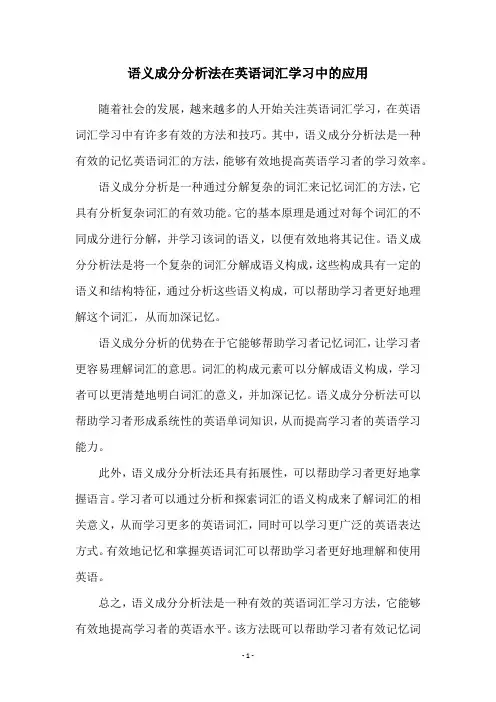
语义成分分析法在英语词汇学习中的应用随着社会的发展,越来越多的人开始关注英语词汇学习,在英语词汇学习中有许多有效的方法和技巧。
其中,语义成分分析法是一种有效的记忆英语词汇的方法,能够有效地提高英语学习者的学习效率。
语义成分分析是一种通过分解复杂的词汇来记忆词汇的方法,它具有分析复杂词汇的有效功能。
它的基本原理是通过对每个词汇的不同成分进行分解,并学习该词的语义,以便有效地将其记住。
语义成分分析法是将一个复杂的词汇分解成语义构成,这些构成具有一定的语义和结构特征,通过分析这些语义构成,可以帮助学习者更好地理解这个词汇,从而加深记忆。
语义成分分析的优势在于它能够帮助学习者记忆词汇,让学习者更容易理解词汇的意思。
词汇的构成元素可以分解成语义构成,学习者可以更清楚地明白词汇的意义,并加深记忆。
语义成分分析法可以帮助学习者形成系统性的英语单词知识,从而提高学习者的英语学习能力。
此外,语义成分分析法还具有拓展性,可以帮助学习者更好地掌握语言。
学习者可以通过分析和探索词汇的语义构成来了解词汇的相关意义,从而学习更多的英语词汇,同时可以学习更广泛的英语表达方式。
有效地记忆和掌握英语词汇可以帮助学习者更好地理解和使用英语。
总之,语义成分分析法是一种有效的英语词汇学习方法,它能够有效地提高学习者的英语水平。
该方法既可以帮助学习者有效记忆词汇,又可以拓展学习者的英语表达能力,是学习英语的有效方法。
由于语义成分分析法的优势,它已经成为英语词汇学习的重要技术,受到越来越多的人的认可。
随着社会的进步,语义成分分析法将越来越受到重视。
因此,在英语词汇学习中应该加强对语义成分分析法的研究和应用,以进一步提高学习者的英语水平。
总而言之,通过有效利用语义成分分析法,学习者可以更快地掌握英语词汇,有效地提高学习者的英语水平。
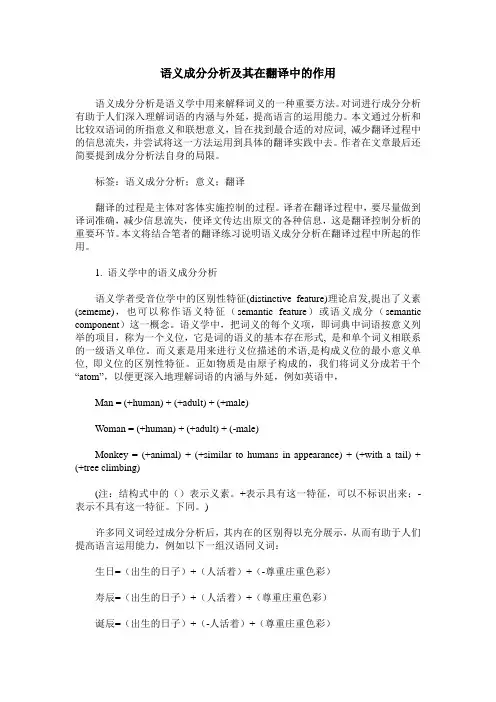
语义成分分析及其在翻译中的作用语义成分分析是语义学中用来解释词义的一种重要方法。
对词进行成分分析有助于人们深入理解词语的内涵与外延,提高语言的运用能力。
本文通过分析和比较双语词的所指意义和联想意义,旨在找到最合适的对应词, 减少翻译过程中的信息流失,并尝试将这一方法运用到具体的翻译实践中去。
作者在文章最后还简要提到成分分析法自身的局限。
标签:语义成分分析;意义;翻译翻译的过程是主体对客体实施控制的过程。
译者在翻译过程中,要尽量做到译词准确,减少信息流失,使译文传达出原文的各种信息,这是翻译控制分析的重要环节。
本文将结合笔者的翻译练习说明语义成分分析在翻译过程中所起的作用。
1. 语义学中的语义成分分析语义学者受音位学中的区别性特征(distinctive feature)理论启发,提出了义素(sememe),也可以称作语义特征(semantic feature)或语义成分(semantic component)这一概念。
语义学中,把词义的每个义项,即词典中词语按意义列举的项目,称为一个义位,它是词的语义的基本存在形式, 是和单个词义相联系的一级语义单位。
而义素是用来进行义位描述的术语,是构成义位的最小意义单位, 即义位的区别性特征。
正如物质是由原子构成的,我们将词义分成若干个“atom”,以便更深入地理解词语的内涵与外延,例如英语中,Man = (+human) + (+adult) + (+male)Woman = (+human) + (+adult) + (-male)Monkey = (+animal) + (+similar to humans in appearance) + (+with a tail) + (+tree climbing)(注:结构式中的()表示义素。
+表示具有这一特征,可以不标识出来;-表示不具有这一特征。
下同。
)许多同义词经过成分分析后,其内在的区别得以充分展示,从而有助于人们提高语言运用能力,例如以下一组汉语同义词:生日=(出生的日子)+(人活着)+(-尊重庄重色彩)寿辰=(出生的日子)+(人活着)+(尊重庄重色彩)诞辰=(出生的日子)+(-人活着)+(尊重庄重色彩)总之,这种将词义进一步分解成一组语义成分的方法,就叫语义成分分析(semantic componential analysis),简称CA。
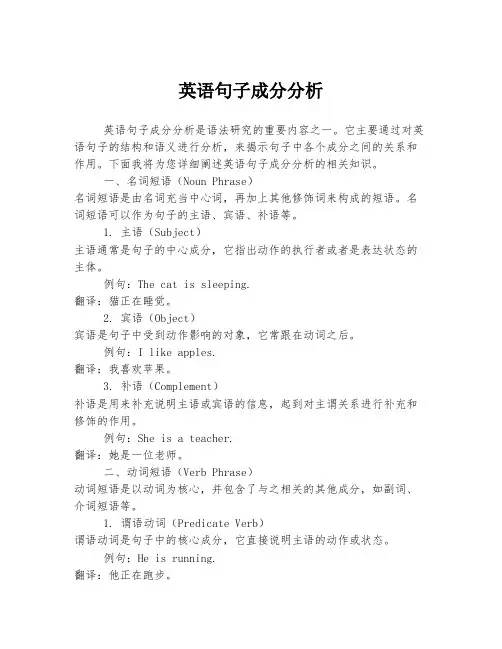
英语句子成分分析英语句子成分分析是语法研究的重要内容之一。
它主要通过对英语句子的结构和语义进行分析,来揭示句子中各个成分之间的关系和作用。
下面我将为您详细阐述英语句子成分分析的相关知识。
一、名词短语(Noun Phrase)名词短语是由名词充当中心词,再加上其他修饰词来构成的短语。
名词短语可以作为句子的主语、宾语、补语等。
1. 主语(Subject)主语通常是句子的中心成分,它指出动作的执行者或者是表达状态的主体。
例句:The cat is sleeping.翻译:猫正在睡觉。
2. 宾语(Object)宾语是句子中受到动作影响的对象,它常跟在动词之后。
例句:I like apples.翻译:我喜欢苹果。
3. 补语(Complement)补语是用来补充说明主语或宾语的信息,起到对主谓关系进行补充和修饰的作用。
例句:She is a teacher.翻译:她是一位老师。
二、动词短语(Verb Phrase)动词短语是以动词为核心,并包含了与之相关的其他成分,如副词、介词短语等。
1. 谓语动词(Predicate Verb)谓语动词是句子中的核心成分,它直接说明主语的动作或状态。
例句:He is running.翻译:他正在跑步。
2. 直接宾语(Direct Object)直接宾语是跟在及物动词后面,指出受到动作影响的对象。
例句:She loves flowers.翻译:她喜欢花。
3. 间接宾语(Indirect Object)间接宾语是在及物动词之后,介词之前,用来指示动作的对象。
例句:He gave me a book.翻译:他给了我一本书。
三、形容词短语(Adjective Phrase)形容词短语是由形容词作为中心词,并可以加上其他修饰词来修饰名词或代词。
例句:The tall girl is my sister.翻译:那个高个子的女孩是我的姐姐。
四、副词短语(Adverb Phrase)副词短语是由副词作为中心词,并可以有其他修饰词来修饰动词、形容词或副词。
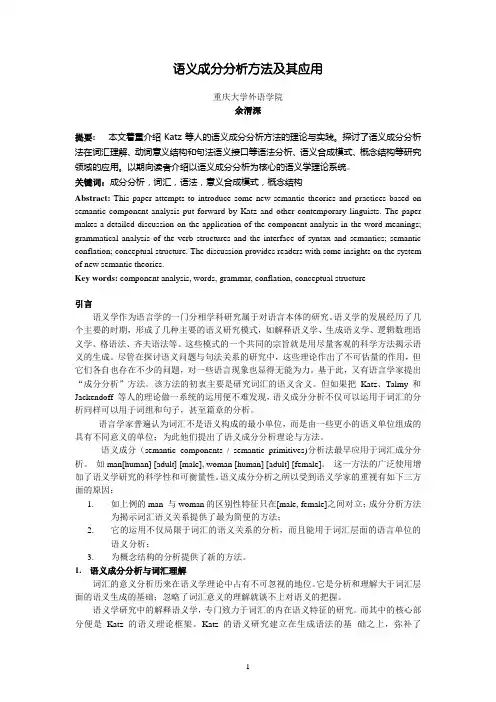
语义成分分析方法及其应用重庆大学外语学院余渭深提要: 本文着重介绍Katz等人的语义成分分析方法的理论与实践。
探讨了语义成分分析法在词汇理解、动词意义结构和句法语义接口等语法分析、语义合成模式、概念结构等研究领域的应用。
以期向读者介绍以语义成分分析为核心的语义学理论系统。
关键词:成分分析,词汇,语法,意义合成模式,概念结构Abstract: This paper attempts to introduce some new semantic theories and practices based on semantic component analysis put forward by Katz and other contemporary linguists. The paper makes a detailed discussion on the application of the component analysis in the word meanings; grammatical analysis of the verb structures and the interface of syntax and semantics; semantic conflation; conceptual structure. The discussion provides readers with some insights on the system of new semantic theories.Key words: component analysis, words, grammar, conflation, conceptual structure引言语义学作为语言学的一门分相学科研究属于对语言本体的研究。
语义学的发展经历了几个主要的时期,形成了几种主要的语义研究模式,如解释语义学、生成语义学、逻辑数理语义学、格语法、齐夫语法等。
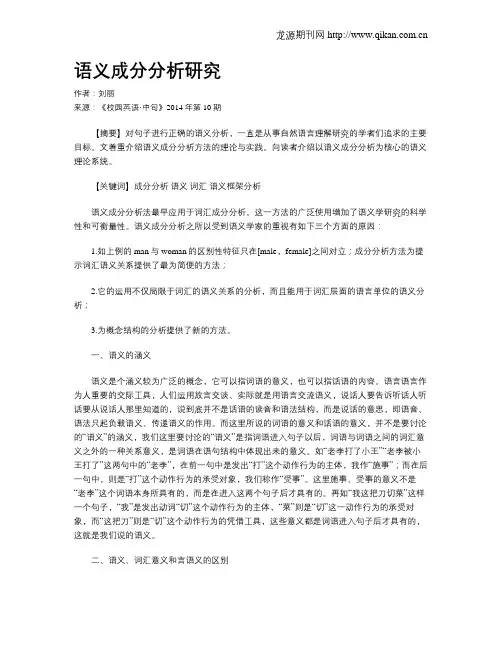
语义成分分析研究作者:刘丽来源:《校园英语·中旬》2014年第10期【摘要】对句子进行正确的语义分析,一直是从事自然语言理解研究的学者们追求的主要目标。
文着重介绍语义成分分析方法的理论与实践。
向读者介绍以语义成分分析为核心的语义理论系统。
【关键词】成分分析语义词汇语义框架分析语义成分分析法最早应用于词汇成分分析。
这一方法的广泛使用增加了语义学研究的科学性和可衡量性。
语义成分分析之所以受到语义学家的重视有如下三个方面的原因:1.如上例的man与 woman的区别性特征只在[male,female]之间对立;成分分析方法为提示词汇语义关系提供了最为简便的方法;2.它的运用不仅局限于词汇的语义关系的分析,而且能用于词汇层面的语言单位的语义分析;3.为概念结构的分析提供了新的方法。
一、语义的涵义语义是个涵义较为广泛的概念,它可以指词语的意义,也可以指话语的内容。
语言语言作为人重要的交际工具,人们运用放言交谈、实际就是用语言交流语义,说话人要告诉听话人听话要从说话人那里知道的,说到底并不是话语的读音和语法结构,而是说话的意思,即语音、语法只起负载语义、传递语义的作用。
而这里所说的词语的意义和话语的意义,并不是要讨论的“语义”的涵义,我们这里要讨论的“语义”是指词语进入句子以后,词语与词语之间的词汇意义之外的一种关系意义,是词语在语句结构中体现出来的意义。
如“老李打了小王”“老李被小王打了”这两句中的“老李”,在前一句中是发出“打”这个动作行为的主体,我作“施事”;而在后一句中,则是“打”这个动作行为的承受对象,我们称作“受事”。
这里施事、受事的意义不是“老李”这个词语本身所具有的,而是在进入这两个句子后才具有的。
再如“我这把刀切菜”这样一个句子,“我”是发出动词“切”这个动作行为的主体,“菜”则是“切”这一动作行为的承受对象,而“这把刀”则是“切”这个动作行为的凭借工具,这些意义都是词语进入句子后才具有的,这就是我们说的语义。
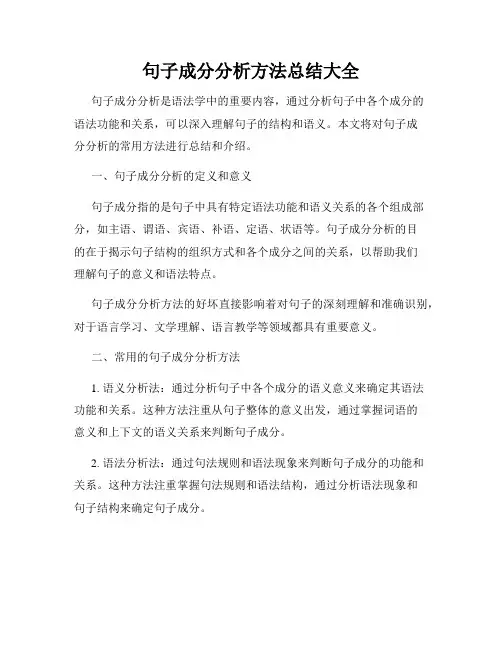
句子成分分析方法总结大全句子成分分析是语法学中的重要内容,通过分析句子中各个成分的语法功能和关系,可以深入理解句子的结构和语义。
本文将对句子成分分析的常用方法进行总结和介绍。
一、句子成分分析的定义和意义句子成分指的是句子中具有特定语法功能和语义关系的各个组成部分,如主语、谓语、宾语、补语、定语、状语等。
句子成分分析的目的在于揭示句子结构的组织方式和各个成分之间的关系,以帮助我们理解句子的意义和语法特点。
句子成分分析方法的好坏直接影响着对句子的深刻理解和准确识别,对于语言学习、文学理解、语言教学等领域都具有重要意义。
二、常用的句子成分分析方法1. 语义分析法:通过分析句子中各个成分的语义意义来确定其语法功能和关系。
这种方法注重从句子整体的意义出发,通过掌握词语的意义和上下文的语义关系来判断句子成分。
2. 语法分析法:通过句法规则和语法现象来判断句子成分的功能和关系。
这种方法注重掌握句法规则和语法结构,通过分析语法现象和句子结构来确定句子成分。
3. 上下文依存分析法:通过分析句子中成分之间的上下文关系来确定其语法功能和关系。
这种方法注重把握句子成分之间的逻辑关系和依存关系,通过分析成分在句子中的位置和连接关系来判断句子成分。
4. 句法树分析法:通过构建句子的句法树来分析句子的成分和关系。
句法树是一种以树状结构来呈现句子成分和句子结构的图表,通过观察句子树的分支和节点来判断句子成分的功能和关系。
5. 语料库分析法:通过收集和分析大量语料库中的语法现象和句子结构来进行句子成分分析。
这种方法注重从大数据角度出发,通过观察和统计语料库中的句子结构和成分特点来进行句子成分分析。
以上述方法为基础,还可以结合语法规则、句子类型、词法特点等进行句子成分分析,从多个角度综合考量,提高分析的准确性和全面性。
三、句子成分分析的步骤和技巧进行句子成分分析时,可以按照以下步骤进行:1. 确定主干:通过确定句子中的谓语来确定句子的主干,然后根据主干来分析其他成分。

祝福语的语义语用分析
祝福语是人们在特定场合或特定时刻用来表达美好愿望和祝福的语言形式。
它
是一种特殊的语言行为,具有特定的语义和语用功能。
祝福语的语义和语用分析,有助于我们更好地理解和运用祝福语,使其表达更加贴切和真诚。
首先,从语义角度来看,祝福语主要表达的是对他人的良好愿望和祝福。
它所
包含的语义成分主要有,美好的愿望、对他人的关心和祝福、对他人的赞美和祝贺等。
比如,常见的祝福语如“祝你生日快乐”、“祝你工作顺利”、“祝你幸福美满”等,都是表达了对他人的美好祝愿和关心。
因此,祝福语的语义特点是积极向上、充满正能量、富有情感色彩。
其次,从语用角度来看,祝福语的使用具有特定的语用功能。
它不仅可以表达
对他人的祝福和美好愿望,还可以在社交场合中起到拉近人际关系、增进情感沟通的作用。
当我们向他人送上祝福语时,往往能够获得对方的回应和感激,从而增进彼此之间的情感联系。
此外,祝福语还可以用来庆祝节日、生日、婚礼等特殊场合,增添喜庆氛围,让人们感受到温馨和幸福。
在实际运用中,我们需要注意祝福语的语用准则。
首先,要根据不同的场合和
对象选择合适的祝福语,避免不当使用导致尴尬或误解。
其次,祝福语的表达要真诚、温暖,不能流于形式化和空洞。
最后,要注意祝福语的语气和语调,让对方感受到真诚和善意。
综上所述,祝福语作为一种特殊的语言形式,具有特定的语义和语用特点。
通
过对祝福语的语义和语用分析,我们可以更好地理解和运用祝福语,使其表达更加真挚和贴切。
祝福语不仅是语言的表达,更是情感的传递,让我们用真诚的祝福语,传递更多的温暖和关爱。
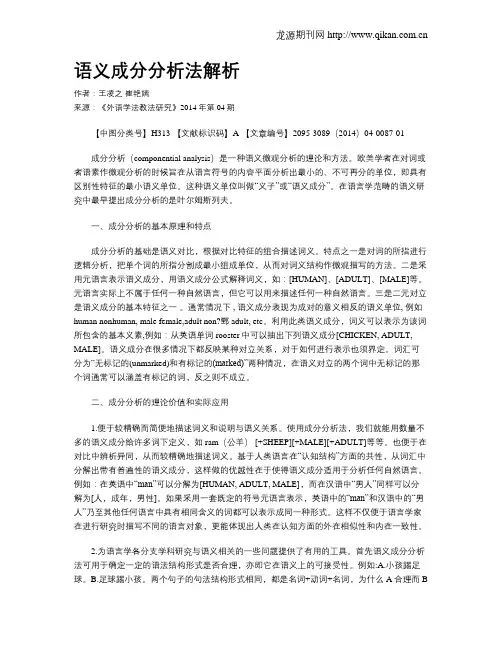
语义成分分析法解析作者:王凌之崔艳嫣来源:《外语学法教法研究》2014年第04期【中图分类号】H313 【文献标识码】A 【文章编号】2095-3089(2014)04-0087-01成分分析(componential analysis)是一种语义微观分析的理论和方法。
欧美学者在对词或者语素作微观分析的时候旨在从语言符号的内容平面分析出最小的、不可再分的单位,即具有区别性特征的最小语义单位。
这种语义单位叫做“义子”或“语义成分”。
在语言学范畴的语义研究中最早提出成分分析的是叶尔姆斯列夫。
一、成分分析的基本原理和特点成分分析的基础是语义对比,根据对比特征的组合描述词义。
特点之一是对词的所指进行逻辑分析,把单个词的所指分割成最小组成单位,从而对词义结构作微观描写的方法。
二是采用元语言表示语义成分,用语义成分公式解释词义,如:[HUMAN]、[ADULT]、[MALE]等。
元语言实际上不属于任何一种自然语言,但它可以用来描述任何一种自然语言。
三是二元对立是语义成分的基本特征之一。
通常情况下 , 语义成分表现为成对的意义相反的语义单位, 例如human nonhuman, male female,adult non?鄄adult, etc。
利用此类语义成分,词义可以表示为该词所包含的基本义素,例如:从英语单词rooster中可以抽出下列语义成分[CHICKEN, ADULT, MALE]。
语义成分在很多情况下都反映某种对立关系,对于如何进行表示也须界定。
词汇可分为“无标记的(unmarked)和有标记的(marked)”两种情况,在语义对立的两个词中无标记的那个词通常可以涵盖有标记的词,反之则不成立。
二、成分分析的理论价值和实际应用1.便于较精确而简便地描述词义和说明与语义关系。
使用成分分析法,我们就能用数量不多的语义成分给许多词下定义,如ram(公羊) [+SHEEP][+MALE][+ADULT]等等。
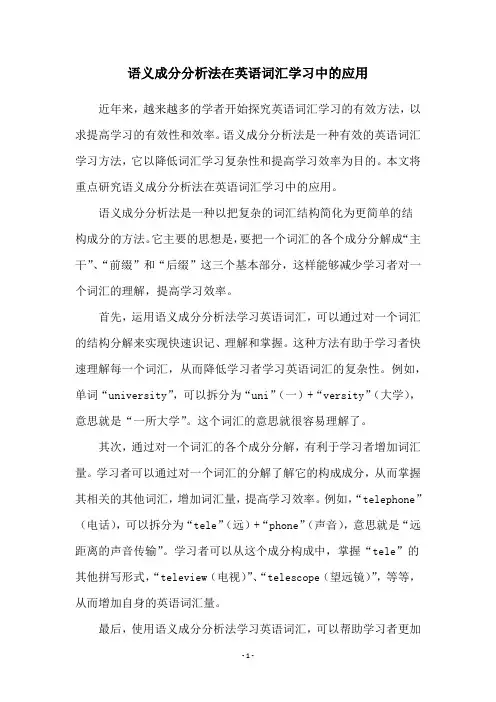
语义成分分析法在英语词汇学习中的应用近年来,越来越多的学者开始探究英语词汇学习的有效方法,以求提高学习的有效性和效率。
语义成分分析法是一种有效的英语词汇学习方法,它以降低词汇学习复杂性和提高学习效率为目的。
本文将重点研究语义成分分析法在英语词汇学习中的应用。
语义成分分析法是一种以把复杂的词汇结构简化为更简单的结构成分的方法。
它主要的思想是,要把一个词汇的各个成分分解成“主干”、“前缀”和“后缀”这三个基本部分,这样能够减少学习者对一个词汇的理解,提高学习效率。
首先,运用语义成分分析法学习英语词汇,可以通过对一个词汇的结构分解来实现快速识记、理解和掌握。
这种方法有助于学习者快速理解每一个词汇,从而降低学习者学习英语词汇的复杂性。
例如,单词“university”,可以拆分为“uni”(一)+“versity”(大学),意思就是“一所大学”。
这个词汇的意思就很容易理解了。
其次,通过对一个词汇的各个成分分解,有利于学习者增加词汇量。
学习者可以通过对一个词汇的分解了解它的构成成分,从而掌握其相关的其他词汇,增加词汇量,提高学习效率。
例如,“telephone”(电话),可以拆分为“tele”(远)+“phone”(声音),意思就是“远距离的声音传输”。
学习者可以从这个成分构成中,掌握“tele”的其他拼写形式,“teleview(电视)”、“telescope(望远镜)”,等等,从而增加自身的英语词汇量。
最后,使用语义成分分析法学习英语词汇,可以帮助学习者更加精准地记忆和使用词汇。
学习者可以从词汇的成分构成中掌握每个词汇的语义,从而更好地掌握词汇的语义特征,使用更精准的词汇表达。
综上所述,语义成分分析法是一种有效的增加英语词汇量和提高学习效率的方法。
它能够帮助学习者快速掌握一个词汇的各个成分,从而达到快速理解,精准记忆和使用词汇的目的。
因此,建议英语词汇学习者学习并使用语义成分分析法,以提高学习英语词汇的有效性和效率。


巴金《家》亲属称谓语语义成分试析作者:程雅丽来源:《东方教育》2018年第25期摘要:本文利用现代语义学理论,以语义场为抓手,选取巴金《家》中丰富的亲属称谓语进行系统统计,并对其进行语义成分分析,结果以图表的形式加以标示,最后总结语义成分分析的一般方法和步骤。
关键词:亲属称谓语;《家》;语义成分亲属称谓语是语言中不可或缺的基本词汇。
巴金的《家》主要是描写与“家”相关的封建家族的兴衰,因而亲属称谓语占据了《家》称谓语的绝大部分。
并且故事发生于五四新旧社会转型时期,时代背景较为特殊,其亲属称谓语系统也极具特色。
本文选取1981年9月北京人民文學出版社出版的第三版本的《家》作为专书进行研究。
语料主要是通过人工穷尽式搜查书中亲属称谓语统计所得。
有关亲属称谓语语义成分的分析主要采用图表的方式展示,每一种亲属关系选择一种称谓形式作为规范。
1.《家》亲属称谓语语义场分析一是对《家》中的亲属称谓语进行统计描绘,总结其主要特征。
二是将这些亲属称谓语分成多个系统,分组列表,做语义成分分析。
1.1《家》中亲属称谓语的统计和描写《家》中亲属称谓语的构成形式与现在的称谓语没有多大差别,主要采用“排行+亲属称谓语”或“姓/名+亲属称谓语”的形式。
如觉民称觉新大哥,觉慧称觉民二哥;瑞珏称梅为梅表妹、称琴为琴妹等。
对于“姓/名+亲属称谓语”的形式本文只保留了其亲属称谓的部分,统计结果如下表:结合文中具体事例,可以总结出其亲属称谓语的几个特点:1.文中无论是直系亲属称谓语,还是旁系亲属称谓语,多数是兼跨背称、面称两类的。
但“妻子”和“丈夫”两个词在书中是一对相对应的称谓,只用于背称,不用于面称,这与今天的用法已然相同。
如:“钰,原谅我,我太懦弱,连自己的妻子也不能够保护我们相处了这几年……我的苦衷你该可以谅解。
”(p331)“自己丈夫做的事你都不晓得!你真糊涂!”老太爷突然把桌于一拍就骂起来。
(p312)2.文中出现的“黑漆板凳”是特殊时代背景的产物,属于英文的音译,是丈夫的意思。
语义成分分析理论与大学英语词汇教学杜丽娉,陈志烈(丽水学院外国语学院,浙江丽水323000)摘要:语义成分分析是把一个词的意义分解为许多语义特征,这些语义特征可以帮助我们比较完整地了解词义,以及词与词之间的关系。
在简述语义成分分析理论的基础上,着重阐述了语义成分分析理论在大学英语词汇教学中的运用,帮助大学生更好地理解单词的含义及语义关系。
关键词:大学英语;词汇教学;语义成分分析理论;词义;语义关系中图分类号:G427文献标志码:A文章编号:1008-6749(2009)01-0098-04A Componential Analysis and College English Vocabulary TeachingDu Liping ,Chen Zhilie(College of Foreign Languages ,Lishui University ,Lishui Zhejiang 323000,China )abstract :Componential analysis is a way that the meaning of a word can be dessected into meaning components ,called semantic features.By specifying the semantic features of certain words ,it will be possible to provide an in-sight into the meaning of words and show how these words are related in meaning.This paper describes briefly the theory of componential analysis ,then highlights the applicatian of the componential analysis in College English vo-cabulary teaching in order to help learners better understand the lexical meanings and sense relations.key words :college English ;vocabulary teaching ;componential analysis ;word meaning ;sense relations 收稿日期:2008-05-20作者简介:杜丽娉(1970—),女,浙江丽水人,副教授,硕士生。
语法分析语义成分、语义特征、语义指向语法分析汉语语法的系统研究始于百年前的《马氏文通》。
学者们一直忙于进行对句法结构中句子成分和词类及句型的分析,即作句法分析,对语义分析和语用分析也涉及一点,大都是不自觉的。
20世纪80年代开始,由于受到国外语法新理论的启发,如生成语法、格语法、功能语法、认知语法,特别是受了符号学的启发,我国学者结合汉语语法研究的实际明确提出了语法研究的三个层面的新理论。
他们认为语法研究应包含句法分析、语义分析和语用分析三方面的内容,应该分清三者并结合起来研究,要加强语义和语用方面的研究,其中对语义方面提出了较多的分析方法。
在吸收了三个层面理论。
但对术语和分析方法没有作定义式说明。
有必要在此对三者作简要的介绍。
句法分析:找出句法结构中的句法成分、指名构成成分的词语类别和词、语、句的整体类型或格式等,也就是对语法单位之间的结构关系和语法单位的类型进行的分析。
语义分析:指出句中动词与有关联的名词语所指事物之间的语义关系,即动作与施事、受事、遇事、工具、时间、处所等关系以及指出其他词语之间的语义关系,如领属、同位、方式等;此外,还包括语义成分、语义指向、语义特征等的分析。
简言之,指语法单位之间的语义关系的分析,实际上是客观事理关系的分析。
语用分析:包括话题和说明、表达重点、语境、省略和倒桩、语气和语调(停顿、重音、句调的升降)等的分析,也就是语言符号与它的使用者、使用环境之间的关系的分析。
下面举几个例子作句法分析:(1)狼咬死了他家的羊。
(带宾主谓句、主动句)主谓动宾中补定中定中(2)狼把他家的羊咬死了。
("把"字句)主谓状中中补(3)他家的羊被狼咬死了。
("被"字句)主谓定中状中定中中补附:这里的"三个层面"也叫"三个平面",指句法、语义、语用,有的学者称"结构、语义、表达"三个方面,有的学者称"语表、语里、语值"小三角。
ponential analysis (语义成分分析法)Componential analysis is a way proposed by the structural semanticists to analyze word meaning. The approach is based upon the belief that the meaning of a word can be dissected into meaning components,called semantic features.2.Synchronic linguistics(共时语言学)The description of language at some point of time in history is a synchronic study.3.Cultural transmission (文化传递性)Language system are not genetically transmitted, but instead have to be taught and learned. It is passed on from one generation to the next through teaching and learning, rather than by instinct. In contrast, animal call systems are genetically transmitted.ngue and parole (语言和言语)The distinction between langue and parole was made by the Swiss linguist F. de Saussure in the early 20th century. Langue refers to the abstract linguistics system shared by all the members of a speech cemmunity, and parole refers to the realization of langue in actual use.petence and performance(语言能力和语言应用)★It was proposed by American linguist N. Chomsky in the late 1950s. Chomsky defines competence as the ideal user’s knowledge of the rules of his language, and performance the actual realization of this knowledge in linguistic communication.6.Inflection (屈折)It is the manifestation of grammatical relationships through the addition of inflectional that are necessary for interpreting the meaning of the sentence.7.Displacement (移位)Language can be used to refer to contexts removed from the immediate situations of the speaker. This is what “displacement”means. This property provides speakers with an opportunity to talk about a wide range of things, free from barriers causes by separation in time or place. 8.Conversational implicature (对话含义)In real communication, however, speakers do not always observe these maxims strictly. These maxims can be violated for various reasons. When any of the maxims is blantantly violated, i.e. both the speaker and the hearer aware of the violation, our language becomes indirection, then conversational implicature arises.9.Arbitrariness (语言任意性)This means that there is no logical connection between meaning and sounds.(no intrinsic connection between the word and the thing it denotes). 10.Minimal pair (最小对立体)★When two different forms are identical in every way except for one sound segment which occurs in the same position in the strings, the two sound combinations are said to form a minimal pair.11.articulatory phonetics (发音语音学)From the speaker’s point of view,“how speakers produce speech sounds”.(The study of the production of speech sounds).12.Deep structure (深层结构)The syntactic structure formed by the XP rule in accordance with the head’s sub-categorization properties, it contains all the units and relationships that are necessary for interpreting the meaning of the sentence, is called deep structure.13.Bilingualism (双语体系)It has been observed that in some speech communities, two languages are used side by side with each having a different role to play; and language switching occurs when the situation changes. This constitutes the situation of bilingualism.14.Sociolinguistics (社会语言学)Sociolinguistics is the sub-field of linguistics that studies the relation between language and society, between the user of language and the social structures in which the users of language live.15. illocutionary act (言外行为)①representative/assertives(陈述):stating or describing, saying that what the speaker believes to be true.②directives(指令):trying to get the hearer to do something.③commissives(承诺):committing the speaker himself to some future course of action.④expressives(表达):expressing feelings or attitude towards an existing state.⑤declarations(宣布):bringing about immediate changes by saying something.1.How do you understand the following semantic triangle?It’s suggested by Ogden and Richard. This view holds that there is no direct link between a linguistic form and what it refers to; rather, in the interpretation of meaning they are linked through the mediation of concepts in the mind. This theory avoids many of the problems the naming theory has encountered, but it also raise a completely new problem of its own. For what is precisely the link between the symbol and the concept remains unclarified.2.Give a generally accepted definition to “language” and state its main features. Language is a system of arbitrary vocal symbols used for human communication.Design features of language: arbitrariness, productivity, duality, displacement and cultural transmission.3.Explain the major aspects in which individual second/foreign language learners are different from each other. Language aptitude—refers to the natural ability for learning a second language. It is believed to be related to a learner’s general intelligence. It has been generally accepted that learners who achieve high scores in language aptitude tests learn rapidly and achieve high proficiency in second language learning. Motivation—defined as the learner’s attitudes and affective state or learning drive, has a strong impact on his efforts in learning a second language. There are four types of motivation have been identified:Instrumental motivation, Integrative motivation, Resultative motivation, and Instrinsic motivation.Learning strategies: learner’s conscious, goal-oriented and problem-solving based efforts to achieve desirable learning efficiency. Motivation plays an important role in learning strategies, those by Chamot and Oxford are widely accepted: Learning strategies, Cognitive strategies, Metacognitive strategies, Affect/social strategies.Age of Acquisition—most study results support the hypothesis that in terms of learning achievement and grammaticality younger learners outperform adults. Personality—In terms of communicative ability rather than grammatical accuracy or grammatical rules, the personality traits such as extroversion, being talkative, self-esteem, self-confidence can be found in successful second language learners.4.In what basic ways does modern linguistics differ from traditional grammar? It is generally believed that the beginning of modern linguistics was marked by the publication of F.de.Saussure’s book “Course in General Linguistics” in the early 20th century.First, linguistics is descriptive while traditional grammar is prescriptive.Second, modern linguistics regards the spoken language as primary, not the written.Then, modern linguistics differs from traditional grammar also in that it does not force languages into a Latin-based framework. 5.Explain Paul Grice’s Cooperative Principle and its four maxims.In Grice’s view, to converse with each other, the participants must first of all be willing to cooperate; otherwise, it would not be possible for them to carry on the talk. This general principle is called the Cooperative Principle, abbreviated as CP.To be specific, there are four maxims under this general principle:⑴The maxim of quantity:①Make your contribution as information as required(for the current purpose of the exchange). ②Do not make your contribution more informative than is required.⑵The maxim of quality:①Do not say what you believe to be false. ②Do not say that for which you lack adequate evidence.⑶The maxim of relation: Be relevant.⑷The maxim of manner:①Avoid obscurity of expression. ②Avoid ambiguity. ③Be brief(avoid unnecessary prolixity) ④Be orderly.6.What the major branches within the scope of linguistics? What does each of them study?The scope of linguistics:phonetics, phonology, morphology, syntax, semantics, pragmatics, applied linguistics, sociolinguistics, psycholinguistics. Phonetics—speech sound(description, classification, transcription), articulatory phonetics, acoustic phonetics, auditory phonetics.Phonology —sound pattern of language.Morphology —the form of words.Syntax —the rules governing the combination of words into sentences.Semantics —the meaning of language (when the meaning of language is conducted in the context of language use—Pragmatics).Applied linguistics —linguistics and language teaching. Sociolibguistics —social factors (eg.class education) affect language use.7.Give a brief account of morphemes in English language with examples. Morpheme—the smallest unit of language that carries information about meaning or function. The word reader, for example, consists of two morphemes: read and -er( to form nouns which refer to a person, animal, or thing that does the action described by the verb), here “reade r”is someone who reads. Similarly, the word boys is made up of the morphemes boy and -s( a plural maker meaning more than one).8.What the major sense relations at the lexical level? Define each of them?1.Synonymy refers to the sameness or close similarity of meaning. It can be divided into the following groups:⑴Dialectal synonyms—synonyms used in different regional dialects. For example, British English “autumn”and American English “fall”.⑵Stylistic synonyms—synonyms differing in style. Here are some examples: start, begin, commence.⑶Synonyms that differ in their emotive or evaluative meaning. For example, the two words collaborator and accomplish are synonymous in that they share the meaning of “a person who helps another”⑷Collocational synonyms. For example, accuse...of, charge...with.⑸Semantically different synonyms. For example, amaze and astound are very close in meaning of “surprised”.2.Polysemy: the same one word may have more than one meaning. For example, the word table have at least three meanings:①a piece of furniture. ②all the people seated at a table. ③the food that is put on a table.3.Homonymy:refers to the phenomenon that words having different meanings have the same form. For examples: rain/reign, bow n./bow v. , fast adj./fast v.4.Hyponymy: refers to the sense relation between a more general, more inclusive word and a more specific word.e.g. Superordinate: flower. Hyponymy: rose, lily, morning glory...5.Antonymy: is used for oppositeness of meaning; words that are opposite in meaning are antonyms. There are three kinds of antonymys have been recognized:⑴Gradable antonyms: e.g. old and young.⑵Complementary antonyms: e.g. alive and died.⑶Relational opposites: e.g. father and son. 9.Why is English rich in synonyms? And how can we classify them?Synonym refers to the sameness or close similarity of meaning.English is rich in synonyms for its historical reasons. In the English vocabulary there are two categories of words: native words and borrowed(loan) words. The native words are those that were originally used in the speech of the native inhabitants of the British Isles. Then in its long history of development, the English language has taken in a large number of words from other language, mostly European languages.⑴Dialect synonyms—synonyms used in different regional dialects.⑵Stylistic synonyms—synonyms differing in styles.⑶Synonyms that differ in their emotive or evaluative meaning.⑷Synonyms differ in their collocation. I.e, in the words they together with. This is a matter of usage.⑸Semantically different synonyms.i.e, the two words amaze and astound are very close in meaning to the word surprise, but have very subtle difference.。
说语义成分范晓(复旦大学中文系,上海 200433)[关键词]语义成分;语义结构;动核;名核;动元;名元[摘要] 语义成分是指语义结构的组成成分。
语义成分与“格”有关系,但不等同。
语义成分分析应和语义特征分析区别开来。
结合汉语实际论述了基本的语义结构(动核结构和名核结构)中的语义成分,认为语义成分有层级的,构建了汉语语法中的语义成分系统:汉语动核结构的语义成分可分为动核、动元和状元三大类,名核结构的语义成分可分为名核、名元、定元三大类,然后对各个大类层层进行细密的下位区分(如动核下分为动作核、性状核等,动元下分为主事、客事、与事等,主事下分成施事、系事、起事等,客事下分成受事、成事等等),并分别对各种语义成分进行了阐释。
还分析了语义成分的转化、兼格等现象。
On Semantic ComponentsFan XiaoKey words:semantic component, semantic structure; verb-nuclear; noun-nuclear; verb argument; noun argumentAbstract: Semantic components refer to the components of the semantic structure. It is related with the case, but not the same with it. Semantic component analysis should be differentiated from the semantic feature analysis. Based on the analysis of the components of the Chinese basic semantic structures, i.e. the verb nuclear structure and the noun nuclear structure, it is concluded that the semantic components are hierarchical, and the semantic component system is constructed. The verb nuclear structure is composed of the verb-nuclear, verb argument and adverbial argument while the noun-nuclear structure is comprised of the noun-nuclear, noun argument and the attributive argument, whose hyponyms are classified and explicated in details. In the end, the semantic components shifts and pluralistic cases are analyzed.语法有句法、语义和语用三个平面,语法结构相应地也有三种,即句法结构,语义结构和语用结构,而作为语法结构的成分也就相应地有句法成分、语义成分和语用成分。
语义成分分析法在英语词汇学习中的应用使用英语学习是当今越来越广泛的现象,其中词汇学习是学习英语的关键所在。
而把握英语词汇的学习规律、积累更多英语词汇,成为学习英语的重中之重。
本文将详细介绍语义成分分析法在英语词汇学习中的应用,以期帮助英语学习者更好地把握英语词汇学习的规律,积累更多英语词汇。
语义成分分析法是近半个世纪英语语言学家重要的研究项目之一,它可以将一个英语句子拆分成主要的语义成分,用这种方式表示句子的句法结构和语义。
它有助于研究人员以及英语学习者理解句子的意义,这是分析英语句子信息处理模型的重要工具。
语义成分分析法在英语词汇学习中应用主要有以下几个方面:一是帮助拆解词义,做到记住词汇而不是背诵单词。
首先,根据语义成分分析,将英语单词和短语拆解成语义小单位,分析它们的词义;其次,记录每个语义小单位及它们的词义,最后,把每个小单位的词义组合起来,从而理解原单词或短语的词义。
二是构建记忆网络,形成词汇联系,有效积累词汇。
通过注意每个语义小单位的细节,分析它们之间的关系,从而为单词或表达式建立记忆网络,把语义小单位、词义及它们之间的联系记住,从而可以有效地积累需要记忆的英语词汇。
三是拓展词汇,加深词义理解。
这是根据每个语义小单位的词义特点,主动组织关联词,进而拓展出与其有关的词汇,从而加深对相关词汇的理解。
最后,语义成分分析法也可以帮助学习者更好地把握句子的结构,提高英语句子结构分析能力,增强词汇记忆效果。
从上面可以看出,语义成分分析法在英语词汇学习中有着重要的应用。
不仅可以帮助学习者更好地拆分词义、构建记忆网络,拓展词汇,而且还可以帮助学习者把握句子的结构,增强词汇记忆效果。
但是,由于语义成分分析法的复杂性,学习者在使用这一方法学习英语时,要掌握一定的英语基础知识,以及英语句法、语义等方面的知识,这样才能更好地运用语义成分分析法学习英语。
综上所述,语义成分分析法在英语词汇学习中有着重要的应用。